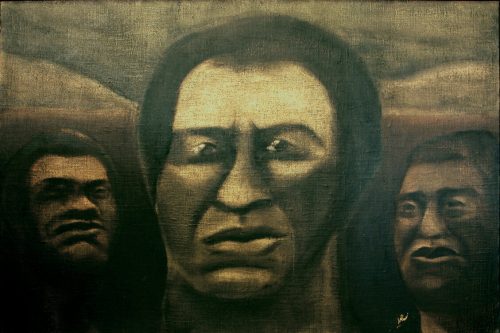
Charming 18th century traveller captured in artwork

Rarely does an art work so accurately express the psychology of its subject than this artwork by Tony Fomison. In Omai, three eighteenth century travellers show the anticipation of a journey across Moana-nui-a-Kiwa to new countries.
In preparation for a fairly major exhibition in 2024, which aims to tell the history of Hawke’s Bay through art works in the Hawke’s Bay Museums Trust collection, we’ve been looking at this wonderful art work Omai. Purchased by the museum’s Foundation patrons in the 1980s it was a thrill to see it out of its crate and up close this week. Visitors to the Museum will have this opportunity in April next year.
The subject of this extraordinary painting is Ma’i, (Omai was a name used for Ma’i by Europeans who lived on Huahine island in Tahiti and who, in 1771, at the age of 22 years, boarded James Cook’s ship HMS Adventure enroute to London.
Ma’i arrived in London some twelve months later and, according to Wikipedia, over his two-year stay in London Ma’i was wined and dined by the literati there. During his stay Ma’i was admired for his ‘charm, wit and good looks’. A wonderful painting by Joshua Reynolds; Portrait of Omai, a South Sea Islander who travelled to England with the second expedition of Captain Cook, painted in 1776 would certainly attest to the later.
And Ma’i’s experiences before he boarded the Adventure, would suggest a fairly colourful character; fleeing invasion of his birthplace Ra’iatea to Tahiti, Ma’i was wounded in an encounter with the ship Dolphin in 1767. In Tahiti Ma’i became an apprentice to a priest until he returned to Ra’iatea where he was captured and taken to Borabora. Narrowly escaping death there, he fled to Huahine. From where Mai’i boarded HMS Adventure.
Two years after ma’i’s arrival in London he began the journey home on HMS Resolution. On route to Huahine, the ship stopped in Totaranui where they picked up two young passengers.
These two young passengers flank Ma’i in Fomison’s portrait. However, they had no such flamboyant beginnings, being only 17 and 12 years old they were still children when they found themselves on board the ship HMS Resolution bound for Huahine Island.
Te Weherua was first to sign up to the voyage and, was likely to have initiated the idea himself. Koa, on the other hand was nominated by his father, to travel as an attendant to Ma’i and probably anticipated Koa would see out his years on Huahine in service of the now quite famous and quite reputable, Ma’i. Koa, was far less keen than Te Weherua and would gladly have remained behind.
Once on board, the ship hit the open sea and Vincent O’Malley writes that the pair began to weep and sing lamentations for their homeland and the people they had left behind. Cook ordered red jackets to be made for the pair in an effort to pacify them, but to no avail.[i]
The pair travelled from Aotearoa to Mangaia, Tonga and finally Huahine, where the pair begged to be allowed to travel on further with the ship, Koa desperately attempting to swim out to the Resolution as it sailed. Sadly both boys died on Huahine within just a few years of their arrival.
That Fomison could so accurately capture the psychology of a journey such as this is quite remarkable. Perhaps it was due to Fomison’s move to Auckland in 1973 and the influence of Samoan culture on his life (Fomison was one of few palagi to receive Samoan tatau).
In some way this work draws on his close connection with the Samoan community who were subject to the Dawn Raids of 1974-6. New Zealand had welcomed Pacific migrants when it needed cheap labour and was quick to send them back home once the need was met or when problems arose.[ii]
Perhaps through his relationship with the Samoan community, Fomison developed an understanding of the mind-set of those mmigrating to new countries. The courage to adapt socially and culturally, the determination of uprooting one’s life, the family buy-in required as well as the need to hold on to one’s cultural identity.
He must have heard of the culture shock, financial worries, frustration and loneliness caused by language barriers and the worries of their children adapting to a new environments – all a part of the Pasifika immigration story. Perhaps it was his understanding of this contemporary immigration story that enabled Fomison to so intelligently express the story of Ma’i.
Omai can be seen online at MTG Hawke’s Bay’s Museum Tai Ahuriri’s website.
Published in the Hawke’s Bay Today newspaper 17 June 2023 and written by Toni MacKinnon, Curator Fine Arts at MTG Hawke’s Bay.
Image: Omai, 1977-78 by Tony Fomison. Collection of the Hawke’s Bay Museums trust collection, Ruawharo Tā-u-rangi. purchase. Reproduced with kind permission from Mary E Fomison.
[i] Vincent O’Malley, Haerenga Early Māori Journeys Across the Globe. Bridget Williams Books Ltd. Wellington (2015)
[ii] https://nzhistory.govt.nz/culture/dawn-raids
19 June 2023



